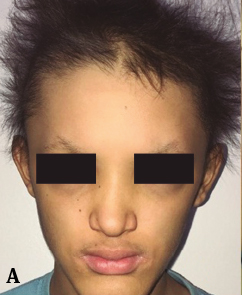Importance of the multidisciplinary approach in patients with hypohidrotic ectodermal dysplasia: about three cases in a family
DOI:
https://doi.org/10.29176/2590843X.50Keywords:
Hypohidrosis, hypodontia, hypotrichosisAbstract
Hypohidrotic ectodermal dysplasia is a genetic disorder defined by the developmental complication of two or more tissues derived from the ectoderm. It has obvious phenotypic characteristics such as hypodontia, hypotrichosis and hypohidrosis. It mainly affects men and has a recessive inheritance linked to the X chromosome. It is important to perform an early diagnosis given the complications associated with this disease. Patients should be treated by a multidisciplinary team of dermatologists, ophthalmologists, dentists, psychologists and social workers. We present the clinical case of a patient and family members with hypohidrotic ectodermal dysplasia, whose diagnosis was clinical and histopathological.
Author Biographies
María Beatriz Reeves, Universidad Santiago de Chile, Santiago, Región Metropolitana, Chile
Médica, residente de Dermatología, Universidad Santiago de Chile, Santiago, Región Metropolitana, Chile
Carla Sepúlveda, Universidad Santiago de Chile, Santiago, Región Metropolitana, Chile
Médica, residente de Dermatología, Universidad Santiago de Chile, Santiago, Región Metropolitana, Chile
Stefanía Toso, Universidad Santiago de Chile, Santiago, Región Metropolitana, Chile
Médico dermatólogo venereólogo, Universidad de Santiago de Chile, Santiago, Región Metropolitana, Chile
María Angélica Macías, Universidad Santiago de Chile, Santiago, Región Metropolitana, Chile
Médico dermatólogo venereólogo, Universidad de Santiago de Chile, Santiago, Región Metropolitana, Chile
Francisco Chávez, Universidad Santiago de Chile, Santiago, Región Metropolitana, Chile
Médico dermatólogo venereólogo, Universidad de Santiago de Chile, Santiago, Región Metropolitana, Chile
Héctor Fuenzalida, Universidad Santiago de Chile, Santiago, Región Metropolitana, Chile
Médico dermatólogo venereólogo, Universidad de Santiago de Chile, Santiago, Región Metropolitana, Chile
References
Al-Ibrahim HA, Al-Hadlaq SM, Abduljabbar TS, Al-Hamdan KS, Abdin HA. Surgical and implantsupported fixed prosthetic treatment of a patient with ectodermal dysplasia: A case report. Spec Care Dentist. 2012;32:1-5. https://doi.org/10.1111/j.1754-4505.2011.00222.x
Vasconcelos M, Romero J, Paiva F, Fonseca T, Nunes A, Carvalho S, et al. Hypohidrotic and hidrotic ectodermal dysplasia: A report of two cases. Dermatol Online J. 2013;19:11.
Crawford PJ, Aldred MJ, Clarke A. Clinical and radiographic dental findings in X linked hypohidrotic ectodermal dysplasia. J Med Genet. 1991;28:181-5. https://doi.org/10.1136/jmg.28.3.181
Wohlfart S, Soder S, Smahi A, Schneider H. A novel missense mutation in the gene EDARADD associated with an unusual phenotype of hypohidrotic ectodermal dysplasia. Am J Med Genet. 2016:249-53. https://doi.org/10.1002/ajmg.a.37412
Thurnam J. Two cases in which the skin, hair and teeth were very imperfectly developed. Proc RM Chir Soc. 1848;31:71-82. https://doi.org/10.1177/095952874803100108
Kere J, Srivastava AK, Montonen O, Zonana J, Thomas N, Ferguson B, et al. X-linked anhidrotic (hypohidrotic) ectodermal dysplasia is caused by mutation in a novel transmembrane protein. Nat Genet. 1996;13:409-16. https://doi.org/10.1038/ng0895-409
Huang SX, Liang JL, Sui WG, Lin H, Xue W, Chen JJ, et al. EDA mutation as a cause of hypohidrotic ectodermal dysplasia: A case report and review of the literature. Genetics and Molecular Research. 2015;14:10344-51 https://doi.org/10.4238/2015.August.28.21
Jones KB, Goodwin AF, Landan M, Seidel K, Tran DK, Hogue J, et al. Characterization of X-linked hypohidrotic ectodermal dysplasia (XL-HED) hair and sweat gland phenotypes using phototrichogram analysis and live confocal imaging. Am J Med Genet. 2013:1585-93. https://doi.org/10.1002/ajmg.a.35959
Wünsche S, Jüngert J, Faschingbauer F, Mommsen H, Goecke T, Schwanitz K, et al. Noninvasive prenatal diagnosis of hypohidrotic ectodermal dysplasia by tooth germ sonography. Ultraschall in Med. 2015;36:381-5. https://doi.org/10.1055/s-0034-1384933
Kaercher T, Dietz J, Jacobi C, Berz R, Schneider H. Diagnosis of X-linked hypohidrotic ectodermal dysplasia by meibography and infrared thermography of the eye. Cur Eye Res. 2014:40:884-90. https://doi.org/10.3109/02713683.2014.967869
How to Cite
Downloads

Downloads
Published
How to Cite
Issue
Section
License
Copyright (c) 2018 Revista de la Asociación Colombiana de Dermatología y Cirugía Dermatológica

This work is licensed under a Creative Commons Attribution-NonCommercial-ShareAlike 4.0 International License.

| Article metrics | |
|---|---|
| Abstract views | |
| Galley vies | |
| PDF Views | |
| HTML views | |
| Other views | |






